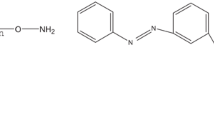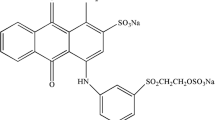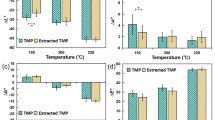Abstract
Simultaneous dyeing and inflaming retarding treatment improves both the aesthetic aspects and the safety value of fast-growing tree species. This study investigated the effects of water bath temperature, dye concentration, flame retardant concentration and dip** time on dye uptake and limited oxygen index of simultaneously dyed and fire-retardant-treated wood veneer. Through comprehensive analysis, an improved process was obtained and wood with these improved properties was prepared. Analyses of chemical structure and thermal stability of prepared wood samples were conducted, as well as crystallinity and microscopic morphologies using Fourier transform infrared spectroscopy, thermogravimetric, plus X-ray diffraction and scanning electron microscopy and energy-dispersive X-ray spectroscopy. Results showed that dye uptake and limited oxygen index had a similar increasing tendency with increased water bath temperature and dip** time. Moreover, dye uptake improved upon addition of flame retardant, while limited oxygen index decreased as dye concentration increases. Flame retardant combined with the wood fiber and was in the absence of chemical reaction with the dye used. Dye and flame retardant molecules diffused into the cell cavity, wood vessel and aperture. Furthermore, the fire-retardant properties and crystallinity of wood simultaneously treated with dye and flame retardant were both improved.









Similar content being viewed by others
References
Arora S, Kumar M, Kumar M (2012) Catalytic effect of bases in impregnation of guanidine nitrate on Poplar (Populus) wood: flammability and multiple heating rate kinetic study. J Therm Anal Calorim 107:1277–1286
Ayrilmis N, Kaymakci A (2013) Fast growing biomass as reinforcing filler in thermoplastic composites: Paulownia elongata wood. Ind Crop Prod 43:457–464
Chen L (2007) Relationship between smoking property and thermal degradation of fire-retardant wood components. Dissertation, Northeast Forestry University
Chen LH, Liu ZJ, Liu Z, **e XF (2008) Effect of small diameter log of populus tomentosa dyeing factors to up-take. For Sci Technol 33:42–45
Chen H, Lang Q, Bi Z, Miao X, Li Y, Pu J (2014) Impregnation of poplar wood (Populus euramericana) with methylolurea and sodium silicate sol and induction of in-situ gel polymerization by heating. Holzforschung 68:45–52
Dong Y, Yan Y, Zhang S, Li J (2014) Wood/polymer nanocomposites prepared by impregnation with furfuryl alcohol and nano-SiO2. BioResources 9:6028–6040
Dong Y, Yan Y, Zhang S, Li J, Wang J (2015) Flammability and physical–mechanical properties assessment of wood treated with furfuryl alcohol and nano-SiO2. Eur J Wood Prod 73:457–464
Dong Y, Yan Y, Wang K, Li J, Zhang S, **a C, Shi SQ, Cai L (2016) Improvement of water resistance, dimensional stability, and mechanical properties of poplar wood by rosin impregnation. Eur J Wood Prod 74:177–184
Fukuta S, Nomura M, Nishizawa M, Yamasaki M, Sasaki Y (2014) Evaluation and fireproofing treatment of wooden heat-insulating/acoustic absorbing materials. Eur J Wood Prod 72:713–720
Guan XM (2011) Research on the computer intelligent color matching technique for simulated precious wood dyeing. Dissertation, Northeast Forestry University
Hong D, Yuan L (2010) Study on environmental-friendly dyeing processes of fast-growing plantation veneers. In: 2010 international conference on bioinformatics and biomedical engineering, ICBBE 2010, April 15–April 18, Chengdu, China, pp 1–4
Hu JH, Li Y, Liu Y, Guo HW, Li L (2016) Evaluation of the dyeing properties of basswood veneer treated by dichlorotriazine reactive dye based on gray correlation analysis. BioResources 11:466–481
Jia Z (2012) The study of nano-CaCO3/fast-growing poplar composite and preparing building templates. Dissertation, Northeast Forestry University
Kumar M, Kumar M, Arora S (2013) Thermal degradation and flammability studies of wood coated with fly ash intumescent composites. J Indian Acad Wood Sci 10:125–133
Li J (2003) Wood spectroscopy technology. Science Press, Bei**g
Li H (2005) Study on dyeing technology of populus tomentosa. Dissertation, Bei**g Forestry University
Li WZ (2011) The preparation technology of flame retardant plywood with decorative and environmental concern. Dissertation, Bei**g Forestry University
Li B, Guo MH (2014) Research and tendency of wood dyeing. Shanxi Archit 40:256–257
Li S, Liu YL (2012) Reactive dyes on the wood veneer dyeing research. In: 2012 2nd international conference on electronic & mechanical and engineering and information technology, EMEIT 2012, December 7–December 8, Shenyang, China, pp 1423–1426
Li M, Yao J, Cui S (2013) New technology of dyeing and finishing. Science Press, Bei**g
Liu XJ (2011) Studies on the artificial dyeing of poplar and Fraxinus mandshurica veneer. Dissertation, Northeast Forestry University
Liu Y, Hu JH, Gao JM, Guo HW, Chen Y, Cheng QZ, Brian K V (2015) Wood veneer dyeing enhancement by ultrasonic-assisted treatment. BioResources 10:1198–1212
Mulinari DR, Voorwald HJC, Cioffi MOH, Rocha GJ, Silva M (2010) Surface modification of sugarcane bagasse cellulose and its effect on mechanical and water absorption properties of sugarcane bagasse cellulose/HDPE composites. BioResources 5:661–671
Na B, Wang ZP, Sun DD, Wang ZQ, Lu XN (2011) Dyeing treatment of veneer from fast-growing poplar by heat-infusing and cold-pressing. J Northeast For Univ 39:41–43
Pan J, Wu ZX, Wang FM, Mu J (2013) Synergistic flame retardancy of poplar treated by MTH/ATH and BL-flame retardant. Wood Process Mach 2:6–31
Pan J, Mu J, Wu ZX, Zhang XT (2014) Effect of nitrogen-phosphorus fire retardant blended with Mg(OH)2/Al(OH)3 and nano-SiO2 on fire-retardant behavior and hygroscopicity of poplar. Fire Mater 38:817–826
Pedieu R, Koubaa A, Riedl B, Wang XM, Deng J (2012) Fire-retardant properties of wood particleboards treated with boric acid. Eur J Wood Prod 70:191–197
Sang BP, Min L, Dong WS, Sang ML, Jong IK (2014) Fire performance of carbonized medium density fiberboard manufactured at different temperatures. J Wood Sci 60:74–79
Song XY, Shen YR (2009) Dyeing with the reactive dyes. China Textile Press, Bei**g, pp 72–76
Sun FL, Duan XF, Feng DJ (2003) General research and tendency of wood dyeing. J Northwest For Univ 18:96–98
Wang YL (2006) Application study of BL-environmental concerned fire-retardant in Particleboard. Dissertation, Bei**g Forestry University
Wang PQ, Tai DS, Liao JY, Li MD (1987) Wood chemistry. China Forestry Publishing House, Bei**g
Wu XF, Yu ZM, Zhang Y (2014) Dyeing property of xylem utilizing the axil direction of freshly-felled Populus cathayana. J Bei**g For Univ 36:125–129
**ong GB (2005) Study on dyeing, enhancement and dimensional stability of fast-growing poplar. Dissertation, Nan**g Forestry University
Yu ZM, Zhao L, Li WJ (2002) Study on permeable mechanism with dyes during wood dyeing. J Bei**g For Univ 24:79–82
Yue K (2008) The study on mechanical properties and durability of modified fast-growing poplar wood. Dissertation, Nan**g Forestry University
Zhang DR (2005) Study on producing technology of dyeing and fire-retardant glue-lumber. Dissertation, Bei**g Forestry University
Zhang L (2007) The application study of BL-environmental friendly fire retardant on textile. Dissertation, Bei**g Forestry University
Zhang XT, Xue L, Zhang Y, Chu DM, Mu J (2016) Pyrolysis characteristics and kinetics of poplar treated by compound N-P flame retardant. J Bei**g For Univ 38:112–117
Zhao J, **e T, Qin J, Zhang Q, Gao XM, Shi CY, Jia SZ (2010) Preparation and properties of different sizes of N-P intumescent flame retardant. Inorg Chem Ind 42:26–28
Acknowledgements
The authors are very grateful for the Co-built Project with Bei**g Municipal Education Commission (2015).
Author information
Authors and Affiliations
Corresponding authors
Rights and permissions
About this article
Cite this article
Wang, X., Zhang, Y., Yu, Z. et al. Properties of fast-growing poplar wood simultaneously treated with dye and flame retardant. Eur. J. Wood Prod. 75, 325–333 (2017). https://doi.org/10.1007/s00107-016-1142-y
Received:
Published:
Issue Date:
DOI: https://doi.org/10.1007/s00107-016-1142-y




